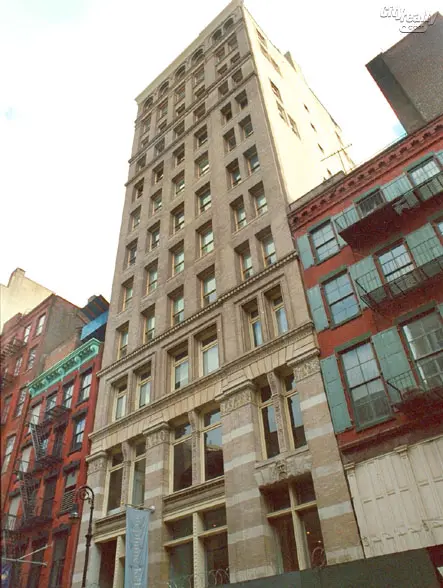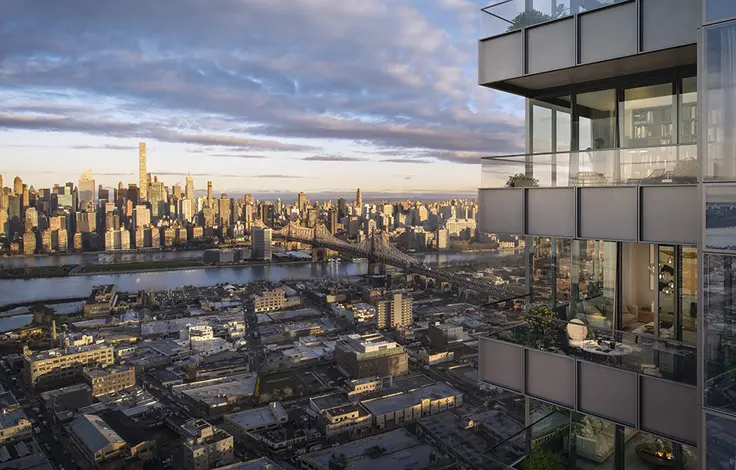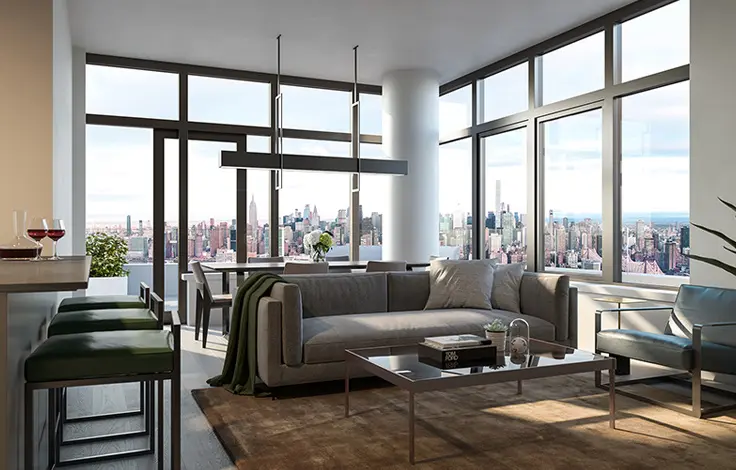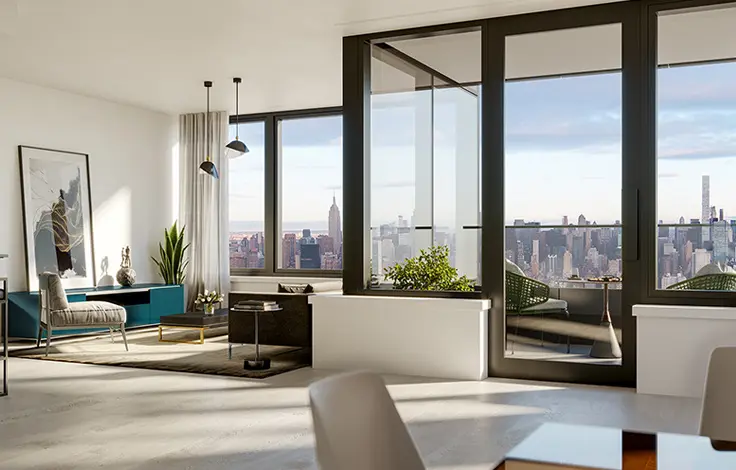The New Museum Building, 158 Mercer Street: Review and Ratings
between Prince Street & Houston Street View Full Building Profile


158 Mercer Street, which is also known as 583 Broadway between Houston and Prince streets, is regarded as a true “kitchen sink” building because its developers tried to cram virtually every conceivable architectural “amenity” into it.
Designed by Cleverdon & Putzel in 1897, the 12-story building was converted from an office building to the New Museum of Contemporary Art in 1996. That institution subsequently moved to the Bowery and the building was then converted to a residential condominium.
The very impressive building, one of the tallest in SoHo, has 19 apartments.
Bottom Line
There are plenty of architectural masterpieces in New York, but few are true "kitchen sink" structures, where the architect has reached into a grab bag of design elements and flung the whole kit-and-kaboodle at the building in a chaotic Jackson Pollock moment. This is the real, glorious thing!
Description
Every floor at 583 Broadway has a different façade treatment, and while the architects employed many conventional elements, they did so with considerable flair and originality.
On the ground floor, for example, there are three large arches, while the entrance at the south has a semicircular top divided into two smaller arches, surmounted by two three-sided windows with two curved sides.
The bandcourse above the sixth floor has two large cartouches, while the one above the eighth floor has five wonderful winged creatures with open mouths.
The building has a large and impressive cornice, and also boasts a lion's head at the top of the fourth floor, on either side of the building, where the sides are slightly indented.
Two-story fluted Corinthian columns between the second and third floors are in stark contrast with the flat granite pilasters with foliate capitals on the ground floor. There are also two-story-high columns with Doric capitals between the 10th and 11th floors.
The fourth floor has arched windows with elaborate entablatures that are repeated on the 12th floor, while the arched windows on the eighth floor have fluted pilaster sides, and the 10th-floor windows are capped with very ornate scalloped pediments and flanked by one-story columns.
Amenities
The building has a 24-hour doorman and concierge, a roof deck and common storage room.
It has no balconies and no sidewalk landscaping.
Apartments
One apartment has a large entry foyer and very long hallway that lead to a living/dining room that runs the entire width of the Broadway frontage next to a very large kitchen with an island and a pantry. The unit has a large library/study at the west end of the building and three bedrooms.
Apartment 5B has a 16-foot-wide entry foyer that opens onto a 42-foot-long living/dining room with a wood-burning fireplace off at 18-foot-long corner windowed kitchen. There is also a 17-foot-long media room, a 16-foot-long office, a 17-foot-long library/family room and three bedrooms.
Another apartment has a small entry foyer across from a 19-foot-long guest room that opens onto a 15-foot-long gallery that opens onto a 47-foot-long living/dining from adjacent to a 17-foot-long kitchen. The apartment also has a 17-foot-long den and two bedrooms with a 29-foot-long dressing room.
Apartment 11B has a 51-foot-long living from with a wood-burning fireplace, an open kitchen with an island and a separate bar with a curved counter. The apartment also has three bedrooms and a 9-foot-long home office.
History
According to a 1997 article in The New York Times, Paul Byard of Platt Byard Dovell Architects, the conversion architect, said that "the building has a "first-class pair of different façades: The 583 Broadway façade - the main entrance for museumgoers, but the back door for residents - is the more ornate one, 'orderly and classical, aimed at the carriage trade,' Mr. Byard said; the quieter side, at 158 Mercer Street, is 'more like a warehouse.'"
The article said that about 1994 "a limited partnership called BPM Associates bought the building, which had been empty for about two decades. Its restoration, begun in November, included the repair of an elaborate cornice so decrepit that, six years ago, the city stepped in to remove pieces that had loosened in the wind and were dangling above Broadway. Inside, many original features remain - Grecian columns, maple floors, brick walls."
The article said that the first floor then housed the Vera Wang Fashion Flagship store.
Singer Jon Bon Jovi bought a penthouse for $24 million in 2007 and offered it for sale in 2011 for $45 million and Andre Balazs, the real estate developer, had an apartment on the 10th floor..
A lengthy and excellent article by Tom Miller on the building ran September 27, 2012 at daytonianinmanhattan.com, noting that John Jacob Astor died at 583 Broadway, one of four Federal-style houses he owned on the block, in 1848, “leaving an estate of around $20 million – approximately $110 billion today.”
The article said that with a few years the “neighborhood quickly became one of exclusive retail emporiums and even restaurants…but the high-tone status of the area remained and the commercial buildings were often constructed of gleaming white marble.”
Astor’s buildings were “long gone by 1896” and several were owned by Weil & Mayer, a real estate firm, which then demolished the buildings and commissioned Cleverdon & Putzel to design a retail store and loft building that they named The Astor Building, according to the article, which described it as “a lush mixture of buff-colored brick, terra cotta, cast iron and stone.”
“The millinery and dry goods district was entrenching itself in the area,” the article said, adding that “the new building filled with apparel and hat manufacturers. C. E. Bentley Company, called by The New York Times a ‘pioneer in the art needle industry’ manufactured lace and embroidery here, and sold related products such as floss and thread. The owners, brothers Charles and Chester Bentley, were nearly wiped out by a fire in 1901. Damage to the structure was quickly repaired and the firm remained here for years….By 1909 C. E. Bentley had a competitor here - Stein, Doblin & Co. was manufacturing and importing embroideries ‘and novelties. In the ground floor retail space that year was Hanauer, Arnstein & Siegel which advertised that ‘We are showing a beautiful line of Children’s Broadcloth Coats with felt bonnets to match.’ The clothing store would be replaced around 1917 by the Eclipse Light Company’s electric light showrooms. The firm would stay here at least throughout the war years, offering modern wall sconces and hanging fixtures and one amazing new gadget: the electric vacuum cleaner….In the 1920s women’s hat makers Oettinger & Goldstein, Inc. and Waldorf Hat Works were both here, as was the Rainbow Shirt Corporation. Spinnerin Yarn Co., Inc. occupied space in the 1940s as did My Girlie Hat Company. Although in 1942 the ground floor store became home to an office furniture and equipment store, the upper floors continued to house garment and hat factories through the 1950s….By now the Garment District was moving north to 7th Avenue in the 30s and the SoHo neighborhood was becoming seedy at best. In the 1970s The Astor Building sat vacant and neglected….In 1993 The New Museum opened in the street level of The Astor Building. The only museum in the city dedicated to exhibiting contemporary art from around the world, the edgy space was a destination for art lovers. But the upper floors remained empty. When the building’s owners decided to convert the space above ground level to a luxury hotel they began by knocking out most of the windows. And then they defaulted on the mortgage and work stopped. Rain, snow and pigeons entered the openings. Sections of the detailed molded-zinc cornice broke loose and dangled precariously over the pavement, inducing city officials to remove parts of it. The one-elegant building became an eyesore. Then, finally, in 1995 The Astor Building was rescued. Platt Byard Dovell Architects was commissioned to renovate the upper floors into 19 loft condominiums. After sitting essentially abandoned for two decades, there would be only two apartments per floor on most levels—each over 4,000 square feet….The New Museum moved on in 2004, yet the building is once again an important element in the fabric of an architecturally rich block.”
Location
The mid-block building is on the same block as Prada, Duane Reade, and Ricky’s and it is close to such eateries as Fanelli’s, SoHo Garden, Delicatessen, Pinkberry, and Balthazar’s and not far from UNIQLO, Old Navy, and Apple, which is to say that it is smack dab in the heart of SoHo and has good public transportation.





 6sqft delivers the latest on real estate, architecture, and design, straight from New York City.
6sqft delivers the latest on real estate, architecture, and design, straight from New York City.
